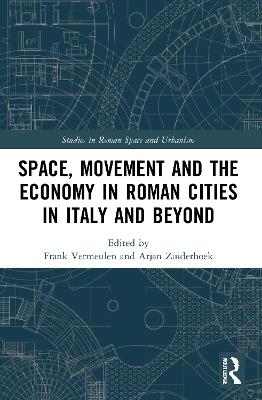
Space, Movement and the Economy in Roman Cities in Italy and Beyond
Routledge (Verlag)
978-0-367-75722-9 (ISBN)
While there exist many studies of Roman urban space and of the Roman economy, rarely have the two topics been investigated together in a sustained fashion. In this volume, an international team of archaeologists and historians focuses explicitly on the economics of space and mobility in Roman Imperial cities, in both Italy and the provinces, east and west. Employing many kinds of material and written evidence and a wide range of methodologies, the contributors cast new light both on well-known and on less-explored sites. With their direct focus on the everyday economic uses of urban spaces and the movements through them, the contributors offer a fresh and innovative perspective on the workings of Roman urban economies and on the debates concerning space in the Roman world.
This volume will be of interest to archaeologists and historians, both those studying the Greco-Roman world and those focusing on urban economic space in other periods and places as well as to other scholars studying premodern urbanism and urban economies.
Frank Vermeulen is a professor of Roman archaeology and archaeological methodology at the Department of Archaeology of Ghent University, Belgium. Arjan Zuiderhoek is an associate professor of ancient history at the Department of History of Ghent University, Belgium.
PART I: Introducing the themes 1. Introduction: space, movement and the economy in Roman cities 2. Economic space and movement between Roman towns, their suburbia and territories: the regional perspective PART II: Spaces 3. Beyond Pompeii and Ostia: commerce and urban space in Roman Italy 4. Market buildings in Asia Minor: old assumptions and new starting points 5. Do economic activities impinge on Roman urban matrices in Asia Minor? A new style/ function debate 6. Elites and economic space in Roman Imperial Asia Minor 7. Making space for commerce in Roman Britain: reevaluating the nature and impact of the forum/ basilica complex 8. The Roman colony of Sena Gallica: urban space and economic activities 9. Aquileia’s market spaces PART III: Movement 10. Finding your way towards the Macellum : the spatial organization of a Roman type of market building 11. How open was the Roman city? Movement and impediments to movement in the street system 12. Transport and trade: an energy expenditure approach for the distribution of marble in Central Adriatic Italy in Roman times 13. “This mule will ruin me”: the economy of mobility in Roman towns 14. Munigua’s place in the operational chain: some considerations regarding the movement of people and goods and the division of labour in the lower Guadalquivir Valley during the Roman period 15. Understanding Rome as a port city 16. Space, accessibility and movement through the Portus Romae PART IV: Conclusion The economics of space and mobility in Roman urbanism
| Erscheinungsdatum | 05.05.2021 |
|---|---|
| Reihe/Serie | Studies in Roman Space and Urbanism |
| Zusatzinfo | 14 Tables, black and white; 11 Line drawings, black and white; 160 Halftones, black and white; 171 Illustrations, black and white |
| Verlagsort | London |
| Sprache | englisch |
| Maße | 156 x 234 mm |
| Gewicht | 840 g |
| Themenwelt | Geisteswissenschaften ► Archäologie |
| Geschichte ► Allgemeine Geschichte ► Vor- und Frühgeschichte | |
| Geschichte ► Allgemeine Geschichte ► Altertum / Antike | |
| Sozialwissenschaften ► Soziologie | |
| ISBN-10 | 0-367-75722-2 / 0367757222 |
| ISBN-13 | 978-0-367-75722-9 / 9780367757229 |
| Zustand | Neuware |
| Informationen gemäß Produktsicherheitsverordnung (GPSR) | |
| Haben Sie eine Frage zum Produkt? |
aus dem Bereich


